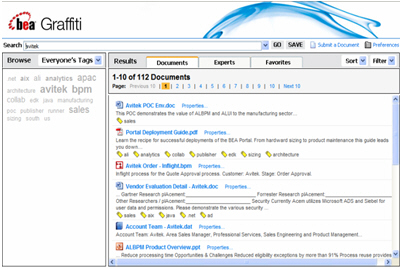BEA showcasing new Web 2.0 portal framework

In December last year, BEA announced a series of new products within its AquaLogic product line, derived from its Plumtree acquisition in October 2005, that would marry Web 2.0 and the enterprise.
The idea, according to David Meyer, vice president of product management at BEA, is that blogs, wikis, mashups, social discovery (as in tags and community search), RSS and REST-based APIs will help liberate users and IT from currently frozen assets, rigid applications and manual processes. Originally due in the second of 2006, the date has slipped to the first half of 2007, Meyer said. 'Linkages in the enterprise aren't hyperlinks, it's people, so Graffiti watches who does what.' At BEAWorld this week in San Francisco, the company is previewing the latest iterations of three new portal products, but more final code for customer testing won't begin until the first quarter of 2007.
The first, code-named “Runner” is designed to help IT deliver the ‘long tail of applications’—basically rogue software, such as REST widgets, that ends up on the network--into the enterprise in a secure and managed way, Meyer said. In talking to customers, BEA found that they had 100 or more rogue Web applications and little control or analytics around them, but the value of those applications outweighed many of the IT-governed applications. “The IP [intellectual property] captured in wikis is not necessarily in a content repository of record, which is too rigid to facilitate much of the cognitive work done today,” Meyer said.
“Runner lets you take the compositing notion in portals and apply it to any application in an enterprise, regardless of the language without having to change its code,” he told me. “It’s an application proxy, a broker or gateway between the browser and back end applications and business logic.” For example, Runner can inject a discussion from collaboration server with other content on portal page without writing any code, or take a record from Siebel and embed it in a wiki page.
According to Meyer, Runner is creating a new kind of portal service. “We don’t see direct competitors, but we are expecting to be confused with things like JotSpot with mashup application frameworks and security products that help grapple with rogue applications. Runner is a net new market category to give an abstraction point for user interface like an enterprise service bus is abstraction point for services.”
A community search product, code-named “Graffiti,” spiders enterprise content and places it in a directory. User can add tags, and Graffiti pools the aggregate data and ranks the content and people. “Systems like Flickr and del.icio.us give control to the masses to self-define content and create much richer data,” Meyer said. “Google had the first ranking algorithm, measuring linkage. However, linkages in the enterprise aren’t hyperlinks, it’s people, so Graffiti watches who does what. What people do constitutes who the experts are within a company.” For example, people who upload the documents that are the most popular about a product are deduced as the best experts on the product.

“Graffiti calculates a search independent weight for everything in the system--projects, people, documents and enterprise data. We have a lot of complex matrix algebra that on various passes produces a rank on every element.” As an example, search results can be filtered by group, such as sales people or developers.
Some privacy issues remain to be resolved around whether people ranks should be exposed and how weighting is configured in the search engine, as well as how to prevent people from gaming the system.
The final product, code-named "Builder," allows users to build composite applications and mashups in a portal with a wiki-like, drag and drop interface. "Builder can pull in enterprise data feeds and place them in a wiki page with right level of governance and security," Meyer said. "IT has a huge cue and this allows business users to create a space and pages, and invite friends to populate it and people with clearance to add any pagelet and authorized data from back end systems." BEA's competitors are also working on similar capabilities in their middleware. IBM, for instance, is developing QEDwiki (Quick and Easily Done wiki), which allows business users to create Web pages with various kinds of components via drag and drop.
The three products work separately or together. Any item registered with Runner, for example, can be added to a Builder page. A pagelet written in Ruby can be embedded in a Java page via Runner. Meyer was not ready to talk pricing regarding the three new products due next year, but they are sure to garner interest among existing customers and those who believe that adding social dimensions to the enterprise will have beneficial results.